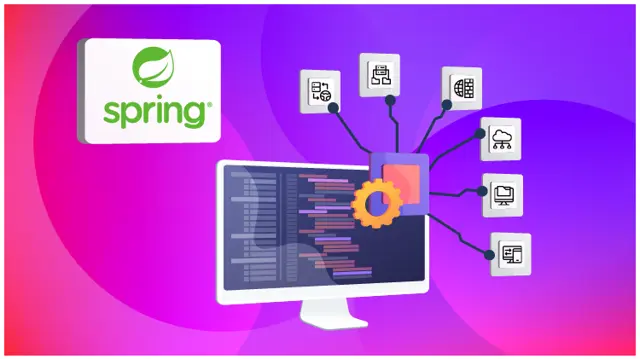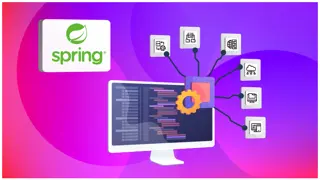
Microservices | Spring Cloud Microservice with Rest API
Microservices ,Spring boot | Learn Spring Cloud Microservice ,Spring Framework with Rest API, ElasticSearch ,RabbitMQ
Oak Academy
Summary
- Reed Courses Certificate of Completion - Free
Add to basket or enquire
Overview
Hi there,
Welcome to my "Microservices | Spring Cloud Microservice with Rest API" course.
Microservices & Spring boot | Learn Spring Cloud Microservice & Spring Framework with Rest API, ElasticSearch & RabbitMQ
Microservices is a growing standard in cloud based software design, used by several companies today. Microservices, or microservices architecture, is an approach to software and website development that breaks down a large project into multiple, independent chunks of code. Each code, called a microservice, gets developed to perform a specific function within the overall software package. Microservices, designed by separate teams, run independently and combine with other microservices to fulfill a larger goal. For example, an e-commerce site includes different functions to manage inventory, product catalogs, customer data, and billing information.
With a microservices approach to site development, they would get separately developed and tested before being combined to create the final website. Microservices get compared to “monolithic” software architecture, in which the entire software package gets developed as a single unit.
Microservices enables developers to break apart applications into a series of decoupled cloud services, containerizing each individual piece. Through this software design method, engineers can implement necessary software changes more swiftly than with standard system architecture.
Dive in now into the"Microservices | Spring Cloud Microservice with Rest API" course.
Microservices & Spring boot | Learn Spring Cloud Microservice & Spring Framework with Rest API, ElasticSearch & RabbitMQ
See you in the course!
Certificates
Reed Courses Certificate of Completion
Digital certificate - Included
Will be downloadable when all lectures have been completed.
Curriculum
Course media
Description
Hi there,
Welcome to my "Microservices | Spring Cloud Microservice with Rest API" course.
Microservices & Spring boot | Learn Spring Cloud Microservice & Spring Framework with Rest API, ElasticSearch & RabbitMQ
Microservices is a growing standard in cloud based software design, used by several companies today. Microservices, or microservices architecture, is an approach to software and website development that breaks down a large project into multiple, independent chunks of code. Each code, called a microservice, gets developed to perform a specific function within the overall software package. Microservices, designed by separate teams, run independently and combine with other microservices to fulfill a larger goal. For example, an e-commerce site includes different functions to manage inventory, product catalogs, customer data, and billing information.
Microservices architecture is a software design approach where an application is divided into a collection of small, loosely coupled, and independently deployable services. Each of these services, known as microservices, focuses on a specific business capability or function. These microservices communicate with each other through well-defined APIs, allowing them to work in harmony to deliver a complete application experience.
With a microservices approach to site development, they would get separately developed and tested before being combined to create the final website. Microservices get compared to “monolithic” software architecture, in which the entire software package gets developed as a single unit.
Microservices enables developers to break apart applications into a series of decoupled cloud services, containerizing each individual piece. Through this software design method, engineers can implement necessary software changes more swiftly than with standard system architecture.
The Spring Framework is a comprehensive framework for Java development that provides infrastructure support, enterprise-level features, and promotes the use of best practices in software design and architecture. It was created by Rod Johnson and was first released in 2003. The primary goal of the Spring Framework is to simplify the development of complex enterprise applications by providing a cohesive, modular, and extensible framework.
Welcome to a transformative journey into Microservices Architecture, a paradigm shift that redefines how we build and deploy applications. Microservices Architecture, often hailed as the cornerstone of modern software development, offers a set of principles and practices that break down monolithic applications into smaller, independently deployable services.
In today's rapidly evolving technology landscape, where agility, scalability, and rapid development are paramount, traditional monolithic software architectures have started to show their limitations. Enter microservices architecture, a modern approach to building software applications that has gained immense popularity for its ability to address the challenges posed by monolithic systems and empower organizations to thrive in the digital age.
Let's explore the advantages and considerations of Microservices First Advantages:
Scalability and Flexibility
Microservices enable horizontal scalability, allowing you to scale individual services based on demand. This flexibility ensures efficient resource utilization and responsiveness.
Modularity and Independence
Services operate independently, promoting modularity. Developers can work on and deploy services independently, fostering parallel development and reducing dependencies.
Technological Diversity
Embrace a polyglot approach, choosing the right technology stack for each service. This flexibility enables optimal solutions for diverse business requirements.
Improved Fault Isolation
Isolate failures to specific services, preventing a single service failure from affecting the entire application. This enhances system resilience and fault tolerance.
In this Microservices course you will Learn;
Installations of the necessay applications
DBeaver
Postman
Lombok
Microservice Architecture
Monolithic Architecture
Spring Cloud Config
Eureka Server
Swagger
Elastic Search
Contains Method
Microservice Communication
OpenFeign
RabbitMQ and Kafka
Zipkin
Spring Cloud Gateway(Api Gateway)
Resilience4j(Circuit Breaker)
Quick Microservice
Let's continue with disadvantages and challenges
Increased Complexity in Deployment and Monitoring
Microservices introduce complexities in deployment, monitoring, and orchestration. Proper tools and practices are essential to manage these challenges effectively.
Coordination Between Services
Ensuring seamless communication and coordination between microservices requires careful design and implementation of communication patterns.
Data Management and Consistency
Managing data consistency and synchronization across microservices can be challenging and requires thoughtful design and implementation.
Seamless Integration with Spring, Spring Cloud, and Docker:
Now, let's delve into how our Spring Microservices Training seamlessly integrates Microservices Architecture with cutting-edge technologies
Spring Framework Mastery
Gain a solid foundation in the Spring Framework, where inversion of control, dependency injection, and aspect-oriented programming form the backbone of scalable and maintainable microservices.
Spring Cloud Technologies
Config Server, Eureka Server, and Api Gateway: Harness the power of Spring Cloud to centralize configuration, enable service discovery, and build a robust API Gateway for seamless communication.
Distributed Tracing with Zipkin:
Implement Zipkin to trace and monitor requests across microservices, gaining valuable insights into system performance and facilitating effective troubleshooting.
Messaging with RabbitMQ
Explore RabbitMQ for asynchronous communication and event-driven architectures, ensuring reliable and decoupled communication between microservices.
Resilience with Resilience4j:
Fortify microservices with Resilience4j, implementing resilience strategies to gracefully handle failures and maintain system integrity.
Containerization with Docker:
Dive into Docker, a powerful containerization platform. Learn to containerize your microservices, enabling consistency and portability across diverse environments.
Embark on this comprehensive training journey and become a master of Microservices Architecture with Spring, Spring Cloud, and Docker.
Why would you want to take this course?
Our answer is simple: The quality of teaching.
When you enroll, you will feel the OAK Academy's seasoned instructors' expertise.
Fresh Content
It’s no secret how technology is advancing at a rapid rate and it’s crucial to stay on top of the latest knowledge. With this course, you will always have a chance to follow the latest data science trends.
Dive in now into the"Microservices | Spring Cloud Microservice with Rest API" course.
Microservices & Spring boot | Learn Spring Cloud Microservice & Spring Framework with Rest API, ElasticSearch & RabbitMQ
See you in the course!
Who is this course for?
Users That Want to Learn Spring and Spring boot.
Users That Want to Learn Spring Rest API.
Anyone who wants to make database operations easier and faster with spring on different Databases.
Anyone who wants to make projects with microservice architecture.
Anyone who is looking to deepen their understanding of backend development and data management.
Software Developers That want to be aware of whats going on at the database level or which database object they can benefit
Requirements
Basic knowledge of Java
Basic knowledge of Spring
Familiarity With SQL or Programming Experience Will Be Good But Not Required
Having a working computer and internet connection
Desire to learn Microservices and Spring Framework
Watching the course videos completely, to the end and in order.
Questions and answers
Currently there are no Q&As for this course. Be the first to ask a question.
Reviews
Currently there are no reviews for this course. Be the first to leave a review.
Legal information
This course is advertised on reed.co.uk by the Course Provider, whose terms and conditions apply. Purchases are made directly from the Course Provider, and as such, content and materials are supplied by the Course Provider directly. Reed is acting as agent and not reseller in relation to this course. Reed's only responsibility is to facilitate your payment for the course. It is your responsibility to review and agree to the Course Provider's terms and conditions and satisfy yourself as to the suitability of the course you intend to purchase. Reed will not have any responsibility for the content of the course and/or associated materials.


